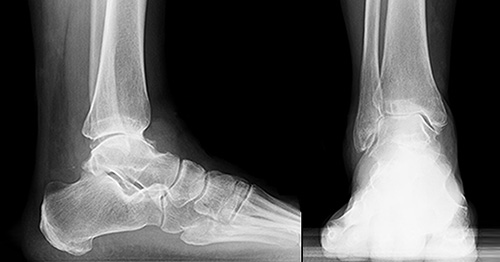Arthritis of the Foot and Ankle
Arthritis can affect both the foot and ankle. Arthritis conditions that most commonly affect the foot (the midfoot or in the toes) include gout, rheumatoid arthritis and psoriatic arthritis. A degenerative arthritic condition known as hallux rigidus also affects the MTP joint of the big toe.

In the ankle, osteoarthritis is the most common form, although rheumatoid arthritis and even ankylosing spondylitis can cause problems with the ankle joint. Ankle arthritis is a common problem in older people, although it can present earlier in life in people who have experienced prior injuries such as a broken ankle.
What is ankle arthritis?
Ankle arthritis is when cartilage in the ankle degenerates and damages the joint. Cartilage is a smooth, spongy tissue that coats the ends of bones where they meet to form joints. It works as a shock absorber and cushions the bones to allow. When cartilage degrades, the bones of the joint rub against one another and become rough and worn.
What causes ankle arthritis?
The degeneration of the ankle cartilage associated with ankle arthritis can be caused by wear and tear over time (osteoarthritis) or from a chronic, rheumatic disease. There are two basic types of arthritis that can affect the ankle: osteoarthritis and inflammatory arthritis (usually in the form of rheumatoid arthritis).
Osteoarthritis (OA), also known as degenerative joint disease, is the more common form. It is a painful condition that occurs when cartilage inside a joint wears down over time. The older we get, the more our cartilage deteriorates – especially in joints that we use most frequently.
What are the symptoms of ankle arthritis?
The common symptoms are pain, stiffness and reduced range of motion of the ankle joint. In osteoarthritis of the ankle, pain usually increases during activity and decreases with rest. Symptoms are often worse toward the end of the day.
Who gets ankle arthritis?
Ankle arthritis occurs in roughly 1% of people, usually as a result of a trauma, such as a fracture or dislocation, years earlier. People under 40 who have had an ankle injury can occasionally get this condition, but most often it develops from a lifetime of use in older people. The older we get, the more our cartilage deteriorates – especially in joints that we use most frequently. About 18% of people over the age of 65 have degenerative changes in their ankle joint.
What are nonsurgical options to treat ankle arthritis?
If the arthritis is not severe, it is usually first treated conservatively with physical or occupational therapy. It is also wise to maintain good nutrition and a healthy weight in order to put less pressure on your joints.
What is the treatment for severe ankle arthritis?
There are three basic surgical options for advanced, end-stage ankle arthritis: ankle fusion (arthrodesis), ankle replacement arthroplasty, or joint-preserving ankle distraction arthroplasty. The choice of which surgery to have depends on the severity of the arthritis, the age of the patient and other factors.
- Ankle fusion reduces or eliminates the pain of end-stage ankle arthritis, but it significantly limits the flexibility of the ankle. This surgery may be performed with either internal or external fixation, depending on the case.
- Ankle replacement surgery can eliminate ankle arthritis pain while preserving the mobility of the ankle joint by replacing portions of bone and cartilage with artificial implants.
- Ankle distraction arthroplasty addresses pain while preserving flexibility by restoring the existing joint surfaces rather than replacing it.
Learn more from the articles below.
Arthritis of the Foot and Ankle Success Stories

